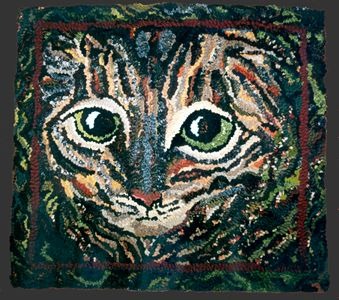search
date/time
 | Lancashire Times Weekend Edition |

Andrew Liddle
Guest Writer
1:00 AM 29th July 2023
arts
From Rags To Riches - The Rug-maker’s Art
.png)
There is a soulful enigma in the eyes of the Hunting Cat. They are watchful, fearless yet wary, bright enough to illumine the feline face in the darkest night. It’s hard to believe that such a powerful image could be made from old rags and tatters.

A chance discovery, in 1988, at an exhibition of rag rugs in a folk museum in Rufford, Nottinghamshire, changed her life. “When I imagined the beautiful effects that could be achieved, making colourful wall-hangings out of rags, I was hooked instantly,” she says, still with a catch of wonder in her voice, “I was strongly attracted to the idea of this craft and I’ve been driven to make rugs ever since.”
At the time she did not realise a revival was under way of an old skill that had been in danger of dying out. She was not, as she imagined, alone in her interest, even though there were no books or classes to aid her and she had to teach herself, picking up what she could from a much older generation.
By this time she and husband, Lewis, had moved from Cornwall to settle, almost on a whim, in York. “We did it on impulse because we both liked this beautiful city.” Happily, she settled very quickly, performing in York and teaching the flute at the Minster School. She began to work with friends to create what was to become a burgeoning craft group.
A single loop of white can create the light in a cat’s eye...
Rug-making was once particularly common in northern wool and textile-manufacturing areas, where there was an abundance of waste material to recycle - and lots of worn-out clothes to cut up. Apparently, each community had its own portable frame, passed round to be worked on by the women when time allowed them to meet.By this means households managed to find a new ‘clippy’ rug for the parlour every year. “Not many examples survive,” Louisa laments, “because they eventually found their way for new uses outside when they grew really shabby from constant usage.”
I was strongly attracted to the idea of this craft and I’ve been driven to make rugs ever since.
Such rugs had a sombre-toned ‘mizzy-mazzy’ random pattern and above all were functional. By working on the upper surface of the rug, rather than the reverse - as was the practice - it became the painter’s canvas and Louisa contributed to elevating the traditional skill into an art form. She works on her lap, looping strips of cloth onto a square of hessian - typically two and a half square feet in dimension - with a rag-rug hook, not unlike a large crochet hook. She brings up strips of material from underneath to form rows of colourful loops on top. This is the essence of what is technically called the hooked rag rug.
.png)
“My rugs are distinguished by using a great many close-toned shades”. The technique might be likened to the pointillist impressionist painter whose work when examined closely is made up of individual dots of colour. “A single loop of white can create the light in a cat’s eye,” she says, thoughtfully.
It is amazing to think that discarded remnants have been given new life and purpose...
Scan her work on-line to see the sense of rhythm of a painting, the pictorial density and delineation that come from this mixing of shades and hues. Castlerigg Stone Circle is a fine example of a landscape, beautifully evoking the Cumbrian sunset gilding the peaks of Helvellyn. The stones cast their own shadows..png)
.png)
Her own recent publication, My Rag Rug Life, "chats around" - as she puts it - some 85 delightful examples selected from more than 200. It perfectly illustrates the range, variety and beauty of her creations and her development as an artist over time. "As my eyesight fails," she considers, "my work necessarily becomes more abstract."
It is amazing to think that discarded remnants have been given new life and purpose, creating wonderfully realistic pictures that evoke the beauty of nature, the atmosphere of ageless monuments and the eternal vastness of the planets.
She believes much of her inspiration for landscapes and animals came from growing up in a particularly beautiful spot in the heart of the chalk downlands, near the Dorset village of Cranborne. Her love of cats is reflected in numerous rugs, the ruffled depth of the fabrics being particularly suitable for depicting the lustre and texture of natural fur – hide and feather.
Louisa Creed began making rag rugs in the late 1980s, long before people were having green thoughts. She succeeded, where alchemy failed, in transmuting dross into gold.
Her genius was to turn rags to riches!
.png)